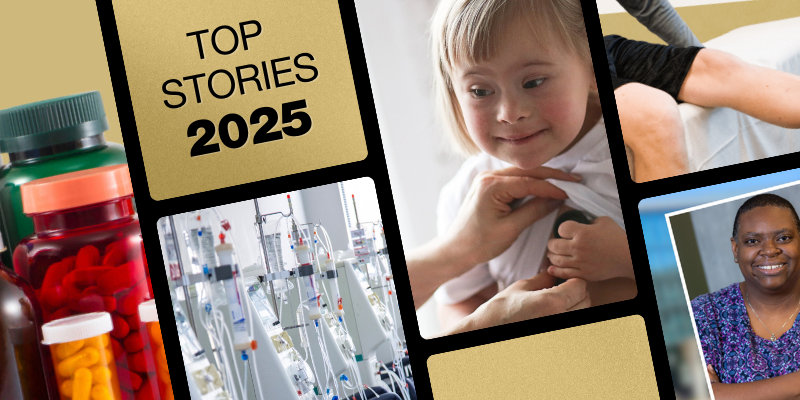“The difficult thing about sepsis is, there's no test that's ever been developed that finds everyone who will become critically ill without finding too many other patients. If we gave them all antibiotics, we would be overusing them. If we hospitalized them all, we would be hospitalizing too many kids, which results in harm for patients and harm for the system. But we never want to miss a single case of sepsis.”
In 2012, a 12-year-old child presented to an emergency department in New York with an unrecognized infection leading to his death. The well-publicized story inspired legislative changes in the state of New York. Preventable deaths due to sepsis became a problem every pediatric hospital started to focus on. Fortunately, research had been building knowledge around emergency treatment of pediatric sepsis before then, and in the years since.
Halden Scott, MD, was in training in the early 2000s and found inspiration in the work being done around sepsis in adult populations at that time. Today she’s a pediatric emergency medicine physician, providing clinical care at the various campuses of Children's Hospital Colorado. Her research is dedicated to better understanding which patients are at the highest risk of developing sepsis and discovering the protocols and interventions that are most effective at prevention.
What is sepsis?
Sepsis can be caused by any infection. It’s defined by becoming a critical illness. So what starts as a simple infection, such as pneumonia or a urinary tract infection, evolves into something that requires critical care. This means their blood pressure drops, they need to be intubated, they need to go to an ICU, they have renal failure, and/ or they have hepatic failure. This is what makes it sepsis.
How does a patient’s illness advance into sepsis?
The conundrum for those of us in the emergency department is trying to treat sepsis before it becomes critical. In some cases, patients will come through our door critically ill, requiring immediate vasopressor support or intubation. In other cases, it’s harder to recognize.
We face two sets of problems. The first is how we mobilize our most intensive resources to get them the right sepsis resuscitation and do this quickly. The second set of problems is this: of all the children who come into the ED with a fever or signs of infection, how do we identify the ones who are at risk of becoming critically ill? My research looks at strategies for early sepsis diagnosis, as well as determining the success of various interventions.
What’s the urgency of this work?
Outcomes from sepsis are driven in large part by how sick you are by the time you get to the ICU. The number of organ system dysfunctions you have by the time you go to the ICU are predictive of death. Even with the best ICU care in the world, sepsis can be hard to reverse if it is not recognized until patients have multiple organ dysfunction.
Sepsis affects more than 75,000 children in the U.S. every year. It's one of the leading causes of death of children around the world. In any ICU on any given day, one in eight kids will have sepsis at that time. Mortality rates depend on the study and how sepsis is defined, so they range anywhere from five to 20%. Beyond mortality, we're increasing our understanding of the long-term consequences for children. Even one year after a sepsis episode, 35% of children have not returned to their baseline quality of life. Many acquire new medical technology, such as a trach or feeding tube post-sepsis. The emotional and physical effects can linger for a long time.
How have you worked with ACCORDS?
In addition to my clinical practice, I had two parallel lines of work going for a long time. I was working on my research, on one hand, and on the other hand, doing quality improvement within the hospital infrastructure. It's with ACCORDS that I integrated these programs and merged clinical and research lines with the science of implementation science.
So, the questions became: how do we improve things using the best available knowledge, and how do we use our findings to improve our knowledge and figure out which interventions make a difference? It’s through mentorship at ACCORDS that I learned how to incorporate these methods. The kind of research I do requires multiple types of methodological expertise and I’m especially fortunate to have mentorship at ACCORDS from the Biostatistics and Analytic Core and from the Mixed Methods and Qualitative Core, as well as from my primary mentor at ACCORDS.
What are you working on now?
The project I’m working on now is funded by AHRQ (The Agency for Healthcare Research and Quality). It’s a career development award, and there are a number of ACCORDS faculty who have mentored specific aspects of it.
We started this project by developing predictive models using a pragmatic approach. First we looked at when a patient first walks through the door: what data do we already have in the electronic health record that might help us predict sepsis and septic shock? Next, we looked at the data we have from two hours after presentation. Since our chance of using lifesaving interventions is lower after two hours, we needed to maximize our prediction of which kids may experience sepsis within the first two hours.
We developed models and validated them. And now we’re running an implementation trial for an EHR alert at the four Children's Hospital emergency departments. In a stepwise fashion, we turned the alert live at each site every 10 weeks, until all sites were live. The trial structure allows us to do something that’s clinically safe in the real world that will not be taken away. It will allow us to compare in a more rigorous way, the care and outcomes of patients who had the alert versus those who did not.
So, this is a real-world design?
Yes. ACCORDS is the master of the step wedge trial. Given the emergency department setting, we couldn’t just give half our providers the alert, because patients don’t have just one provider. We’re also using a framework to measure outcomes that are based in implementation science. We're seeing how the alert changed the processes of patient care, and seeing whether it changed patient outcomes. We’re also looking at how the alert affected providers, including which providers used it and which ones ignored it. We've also paired a qualitative study to find out how the providers experienced the electronic alert.
Is the alert the only thing you’re testing?
We're testing a bigger concept in the electronic health record. I have this idea that drawing people's attention to a high-risk patient, without telling them exactly what to do, will make them more receptive to the alert. The difficult thing about sepsis is, there's no test that's ever been developed that finds everyone who will become critically ill without finding too many other patients. If we gave them all antibiotics, we would be overusing them. If we hospitalized them all, we would be hospitalizing too many kids, which results in harm for patients and harm for the system. What we’re asking providers to do when they receive this alert is to look at the suggested labs should they decide to escalate care. Mostly we're asking them to watch the patient more closely. Electronic health records don't like building that kind of alert, as they really only want to build an alert that directs us specifically to an action. But our tests aren’t good enough to do that yet. So, we’re identifying this higher-risk pool and asking providers to apply extra clinical care and make good decisions. Our hypothesis is that this will work. But that's what we're running the trial to find out.
What are your next steps?
The trial ends on March 1, so we will have our data on March 31. We hope to present results sometime this year. Our whole team will work together to interpret the data and follow our analysis plan so we can present the data. We also had qualitative interviews that will finish before the trial ends to get providers’ first impressions. But we’re adding the step that's a little separate from the research process, to ask our teams if they want to keep the alert and how we might change it. This has been a hallmark of my research and clinical career, always making sure this integration and back and forth between what we're doing clinically, and trying to make sure we're always clinically giving the best standard of care, while simultaneously doing research and getting data that will make our standard of care better.
If we had to pick one theme that came up in our qualitative interviews, it was clinicians are suffering from alert fatigue. They only want to be alerted to things that really matter. Fortunately, septic shock seems to really matter to them, and they'd rather be interrupted.




